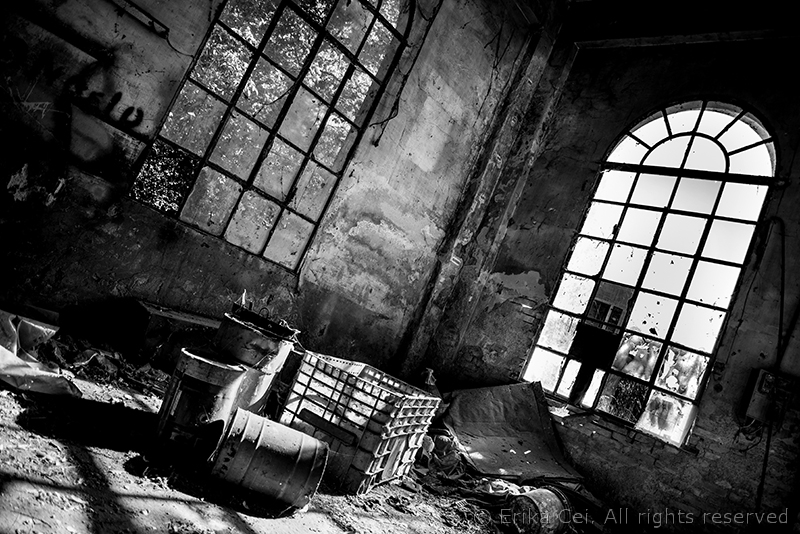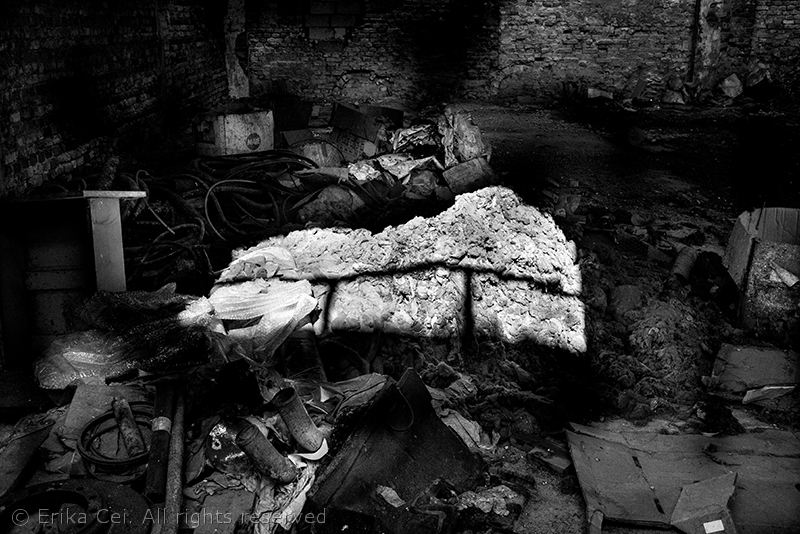The Pordenone area case
From the mid-19th century till the late 1980s, five big cotton mills were working in the Pordenone area (northeastern Italy): three of them in Pordenone (Borgomeduna, Torre, Rorai Grande), one in Cordenons and one in Fiume Veneto.
With the exception of a part of the old dye works in Torre, all the other sites are completely abandoned and have become cemeteries, in a very real sense. No human beings are buried there, just their past. It's not necessary to bring flowers there: plants of every kind freely grow on the stories of more than 12.000 people (mostly women) who worked there.
Pictures below (taken in Borgo Meduna, Cordenons and Torre) clearly show the very serious state of decline of these sites. I'm quite willing to say that it always breaks my heart to see our history treated like trash, without any respect for all the people who actually made that history, as did mrs Maria Colin, mrs Ortenilla Bailot, mrs Candida Canton, who started working in the cotton mills when they were 13, 12 and 11 years old respectively.
"I got to a certain age and I worked in a ward where there has always been just a few of us. Those few have already died because they were older than me", said Lucia Radegonda, former cotton mill worker (source: Friuli occidentale la storia le storie).
Let's make sure that the cotton mills and the stories of their workers don't die too. This is exactly what the volunteers of the association "Il mio Makò" are trying to do in Cordenons (which will be the subject of the following post) and their battle is anything but easy. The other cotton mills are simply gasping for life.
Mrs Colin, mrs Bailot, mrs Canton, mr Radegonda and other former workers of the cotton mills in the Pordenone area were interviewed a few years ago by some local historians. All the interviews are available (italian only) here.
For brief historical info (italian only) about the cotton mills in the Pordenone area click here (no direct link, you have to use the search box)
That's all.
With the exception of a part of the old dye works in Torre, all the other sites are completely abandoned and have become cemeteries, in a very real sense. No human beings are buried there, just their past. It's not necessary to bring flowers there: plants of every kind freely grow on the stories of more than 12.000 people (mostly women) who worked there.
Pictures below (taken in Borgo Meduna, Cordenons and Torre) clearly show the very serious state of decline of these sites. I'm quite willing to say that it always breaks my heart to see our history treated like trash, without any respect for all the people who actually made that history, as did mrs Maria Colin, mrs Ortenilla Bailot, mrs Candida Canton, who started working in the cotton mills when they were 13, 12 and 11 years old respectively.
"I got to a certain age and I worked in a ward where there has always been just a few of us. Those few have already died because they were older than me", said Lucia Radegonda, former cotton mill worker (source: Friuli occidentale la storia le storie).
Let's make sure that the cotton mills and the stories of their workers don't die too. This is exactly what the volunteers of the association "Il mio Makò" are trying to do in Cordenons (which will be the subject of the following post) and their battle is anything but easy. The other cotton mills are simply gasping for life.
Mrs Colin, mrs Bailot, mrs Canton, mr Radegonda and other former workers of the cotton mills in the Pordenone area were interviewed a few years ago by some local historians. All the interviews are available (italian only) here.
For brief historical info (italian only) about the cotton mills in the Pordenone area click here (no direct link, you have to use the search box)
That's all.
















bellissime foto Erika, rendono molto bene l'atmosfera di interessanti archeologie a torto abbandonate da troppi anni ormai...
RispondiEliminaLa radio brionvega! Non ci posso credere. Tutte bellissime
RispondiElimina